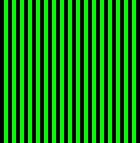McCollough effect
Appearance


The McCollough effect is a phenomenon of human vision: Colorless gratings appear colored contingent on the orientation of the gratings. People need time to see the effect. For example, if someone looks at a red horizontal grating and then at a green vertical grating for a few minutes, a black-and-white horizontal grating will look greenish and a black-and-white vertical grating will then look pinkish. The effect is remarkable for often lasting up to three months or more.
The effect was discovered by American psychologist Celeste McCollough in 1965.[1]
References
[change | change source]- ↑ McCollough, Celeste (3 September 1965). "Color Adaptation of Edge-Detectors in the Human Visual System" (PDF). Science. 149 (3688): 1115–1116. Bibcode:1965Sci...149.1115M. doi:10.1126/science.149.3688.1115. PMID 17737844. S2CID 29075991.
